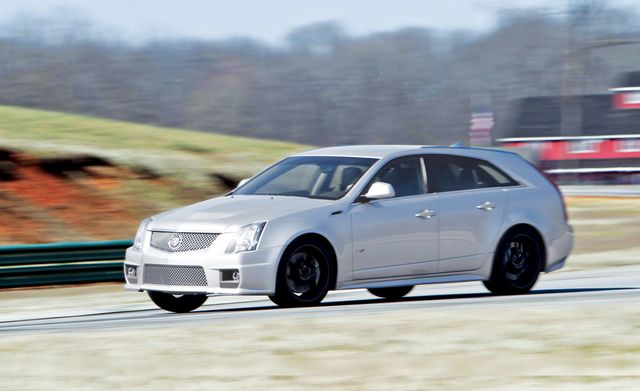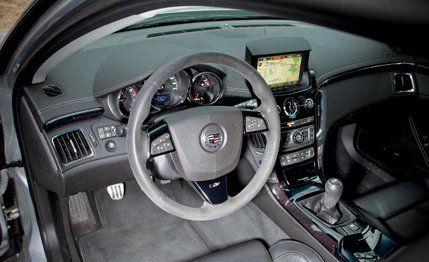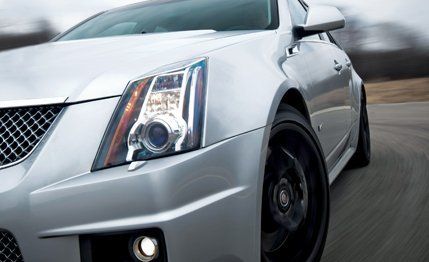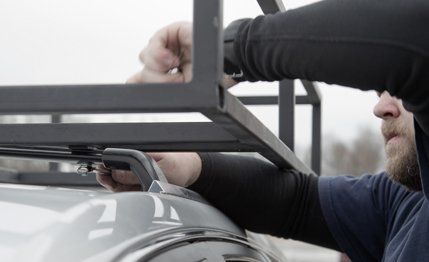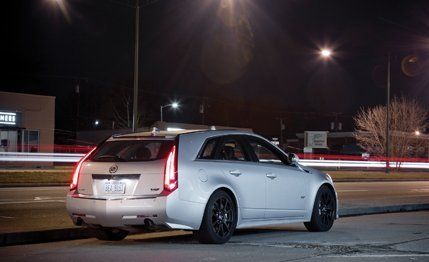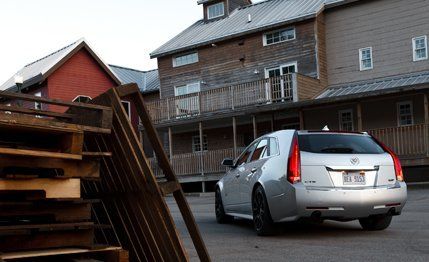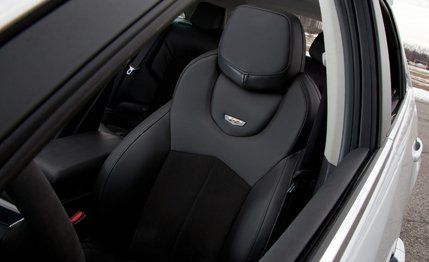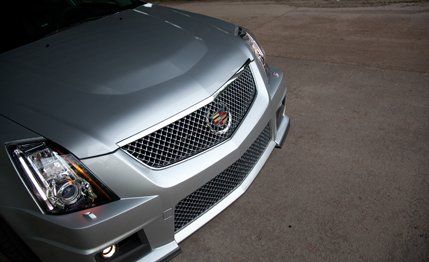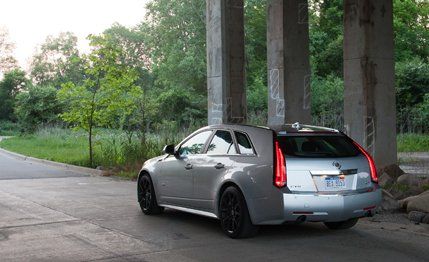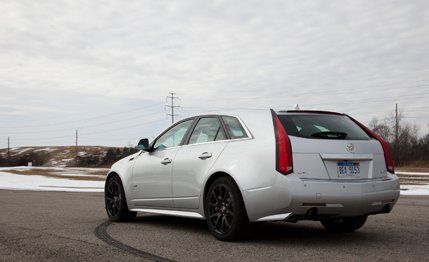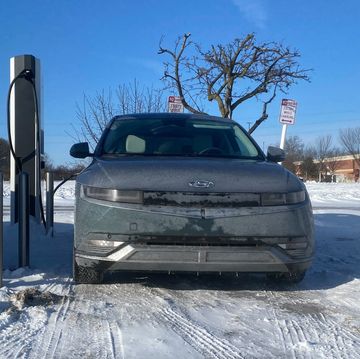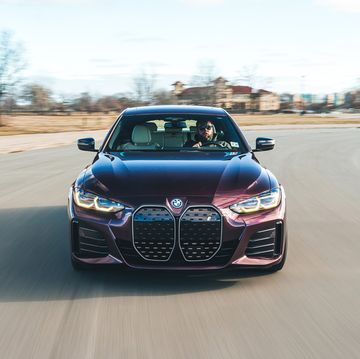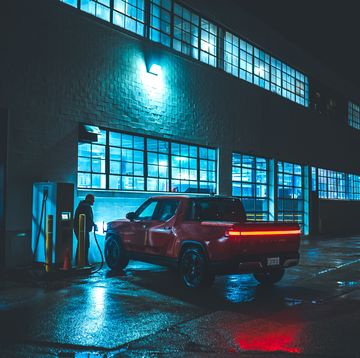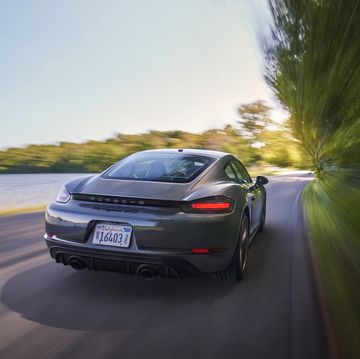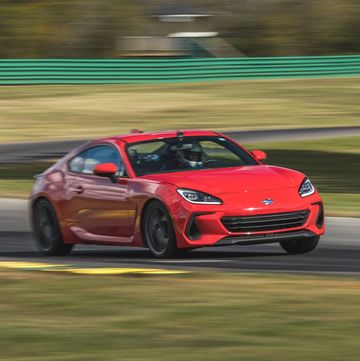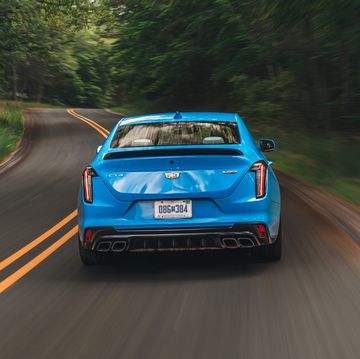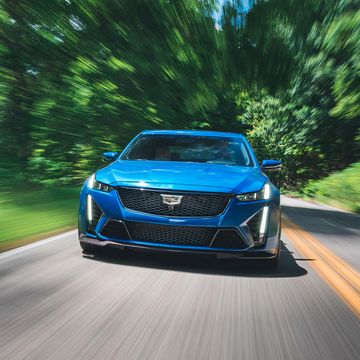From the June 2012 issue of Car and Driver.
If any vehicle on the market today could be considered the automotive equivalent of baseball’s five-tool player, the Cadillac CTS-V wagon would be it. Okay, so a car doesn’t have batting power, or base-running or fielding abilities. But the CTS-V five-door has an undeniably broad portfolio of talents: It can eat corners like it does highway miles, devastate the ego of many a stoplight warrior, and haul kids or anything else you can fit through the hatch or on the roof. After the wagon collected two consecutive 10Best trophies starting in 2010 (2012 made it three in a row), we felt it was time for a 40,000-mile playoff with this automotive dynasty. Cadillac had one caveat: We had to help build the car.
We saw the crafty hand of Caddy’s PR department in this gambit—“Of course it fell apart; you guys built it!”—but who wouldn’t play along? Besides, the potential for catastrophe was limited: We were only allowed to tack, stick, and bolt on the car’s nonessential bits. Major-element installations would be handled by the UAW pros. So a handful of editors convened at the Lansing Grand River assembly plant at oh-dark-thirty one morning in October 2010 to follow our V wagon down its serpentine line. We looked on as workers bolted in $3400 Recaro seats, married the powertrain (including a six-speed manual transmission) to the body, and attached our car’s faux-suede-wrapped steering wheel and shift knob ($300). They supervised us as midnight sapele wood trim ($600) was pressed into place by our minimally trained hands. We did convince the LGR crew to let us sign the spare-tire well before putting the trim in place.
The day’s operation, including a shakedown, took the better part of eight hours. When we left the factory, our V would be transported to a dealership, where a technician would prep the car for delivery to our office.
Our baby arrived in mid-December, after two months of labor. That meant we immediately had to slap on some Pirelli Winter 240 Sottozero tires ($1222) because there was no way the CTS-V’s Michelin Pilot Sport PS2s could keep it safe in even the lightest dusting of snow. Cadillac sent us a set of black wheels (an option that wasn’t available at the time of our build) to serve as winter-tire hosts; our staff became so fond of the dark-wheels/silver-body contrast that we ended up staying with the black wheels for our summer tires when spring broke.
Excessive doting ensued. Staff members unanimously praised the car’s abundance of power, its uncompromised ride, and its eager-to-corner chassis. Initial testing put some numbers to the output we were bathing in daily. Standstill to 60 mph took just 4.1 seconds, and the quarter-mile cracked off in 12.3 seconds at 119 mph. And our 4393-pound wagon stopped from 70 mph in 158 feet and could hold the road with 0.89 g. There was little the CTS-V could do wrong.
Which is not to say that nothing went wrong, even though we didn’t have to spend a dime on service: All 2011 and newer Cadillacs come with free scheduled maintenance for four years or 50,000 miles. The V’s onboard computer called for five services over our 40,000-mile test. The first came at about 7000 miles, and subsequent visits took place at intervals ranging from 7K to 10K miles. All the scheduled services were pretty basic, including a multipoint inspection and an oil and filter change. Surprisingly, the air-filter element was never swapped out.
Making the switch from winter to summer rubber revealed a bent wheel, a common problem in our long-term fleet. Replacing it cost us $625, but that would be the only wheel that fell victim to Michigan’s potholes.
The first teething problem coincided with the car’s initial service, where we asked our dealer to inspect a clicking noise we detected in the steering. It turned out that the upper intermediate shaft in the column was bad and needed to be replaced. The warranty covered the bill.
Some 3000 miles later, technical editor Mike Austin was the first to experience a much larger issue that took five months and four trips to the dealer to remedy. Austin was departing San Antonio, Texas, for Ann Arbor when—after spraying off 2500 miles’ worth of road-trip bugs in a carwash—the right-rear window rolled itself down and refused to go back up. A local Caddy dealer got the glass closed and disconnected the window motor so the V could make it back to Michigan. Our dealer reconnected the wiring and found what its technicians thought was a faulty window regulator, which they replaced. The problem, however, persisted.
Another 3000 miles passed, and the window gremlin reappeared. Again, a carwash activated the problem (water was a theme). The dealer re-greased some of the electrical connections in the door’s wiring, and operation returned to normal. The final instance happened in the rain. This time, the dealer replaced the wiring harness in the right-rear door after discovering some corrosion on a few of its connections. Problem solved.
The whole ordeal did not cost us anything more than some shaken confidence in the CTS-V’s weather resistance.
Austin’s road trip also opened our eyes to the V’s biggest day-to-day drawback: fuel consumption—or, rather, lack of effective range. The fuel tank holds just 18.0 gallons, and we typically refilled it every 200 miles under mixed city and highway driving. And even though highway range could extend beyond 300 miles, it is safe to say no CTS-V will be challenging the Cannonball record without augmented fuel capacity.
As a testament to how much we enjoyed the Cadillac’s 556 horsepower, we averaged 15 mpg. That’s 6 mpg worse than we netted with a 416-hp, 2008 Lexus IS F long-termer and just 1 mpg better than our 2009 Dodge Ram 1500 over the course of its 40,000 miles.
Later in the V’s tour of duty, the clutch-return spring broke, producing a clicking sound every time the third pedal went to work. Again, the dealer repaired this annoyance at no cost to us. At about this time, the summer tires wore out at slightly different mileages, making us $2072 poorer (including installation and balancing).
While the V was in its second winter with us, someone noticed that it had never turned a single hot lap at a track. To remedy this glaring oversight, we built a roof rack made of one-inch steel tubing that could carry three tires. We attached it using a set of $325 crossbars from the Cadillac parts counter. With the rack fitted, we could drive from a harsh climate to a more temperate one with the safety of winter tires underfoot and without the pungent odor of track-abused rubber filling the cabin on the way back. Plus, it would give us room to take four people, which we would have done if we had friends.
At Virginia International Raceway, the wagon performed nearly as well as the CTS-V sedan we ran there during the 2008 installment of our Lightning Lap event. The 40,000-mile brakes made their presence felt—the pedal was a tad soft when scrubbing down speed from the 140-plus-mph front straight.
But any inkling that the V was getting tired was laid to rest when we performed instrumented testing on it after it chalked up 40K miles. The wagon was 0.1 second quicker to 60 mph than when new and posted an identical quarter-mile ET, just 1 mph slower. Skidpad grip was up ever so slightly, and braking distance grew by a yard. All things considered, the initial and final tests were right on top of each other, with little discernible difference. Beat, this V was not.
The final logbook commenter wrote wistfully about life with the V and noted that this would likely be his last time driving it. He was not alone in his melancholy—that remark could have come from anyone on our staff. How often do you get to spend 40,000 miles with a do-anything, haul-everything, 185-mph, scare-everyone wagon? Only a cyborg, bereft of emotion, wouldn’t miss it.
If you happen to buy a used silver CTS-V five-door, peel back the spare-tire-well trim to see if it was our long-term car. If you find it, give us a call. We would love to check up on our baby.
Date: October 2011
Months in Fleet: 10 months
Current Mileage: 28,378 miles
Average Fuel Economy: 15 mpg
Average Range: 270 miles
Service: $0
Normal Wear: $1078
Repair: $0
Damage and Destruction: $1818
Since we last checked in with our long-term Cadillac CTS-V wagon, the car has finally overcome its case of electronic window-itis. A recap: The right rear window kept rolling itself down, most notably doing so once during a carwash. On our third trip to the dealer, techs found corrosion in the door’s wiring harness. They replaced the whole harness, and cavities that could collect water were packed full of dielectric grease to prevent the ailment from returning. Although the window has been by far our biggest problem with the V, we’ve had a few other issues, some we can blame on ourselves and a few that we can’t.
One cold morning, a staffer entered the car and noticed the clutch pedal lying on the floor, not in the normal up position. A simple lift of the pedal returned it to the proper place, after which it worked normally. The spring that handles the duty of keeping the pedal up was out of place and continued to occasionally snag it, trapping the pedal on the floor. Like the window problem, this repair was covered under warranty; also like the window problem, it has happened more than once. So far the clutch-spring fault count is two, although it’s starting to make noise again, and we’ll be taking it back to the dealership soon. We’re beginning to wonder if we’re too hard on the third pedal.
Softballs, Science Tricks, and Repair Bills
A softball-sized dent appeared in the right-rear corner of the V, and out of ignorance or embarrassment, nobody claimed responsibility for it. One staff member theorized that a low-pressure pocket had developed beneath the fender, causing the sheetmetal to cave in like the old collapsing-can junior-high science trick, but his theory had few supporters. A local body shop repaired and refinished the corner for $997.
We had reported in June that the CTS-V’s right front wheel had been badly damaged and needed to be replaced. A second front wheel became bent, the likely victim of a Michigan pothole, so we again relied on the services of Alloy Wheel Repair Specialists of Michigan (www.awrsm.com). They come to you and repair damaged wheels on the spot, even repairing curb rash and handling painting. This time, they charged $135 for the 15-minute repair. We’re told that some wheels are too damaged to repair (when the bend travels into the spokes, for example), and cheap aftermarket rims often cost less to replace than fix, but we’re very happy with the service. The convenience of the on-the-spot repair is unbeatable, and $135 is a lot cheaper than the $566 price of a new wheel.
Right after the wheel was repaired, one of our road warriors noticed the rear tires were on the wear bars, despite having fewer than 20,000 miles on them (winter tires did duty in the snowy months). After a quick hunt for suitable rubber, we opted for OE-replacement Michelin Pilot Sport PS2s because, well, they’re good tires. Besides, the OE PS2s are designed specifically for the CTS-V, as denoted by the “TPC SPEC” marking on the sidewall. Balanced and mounted, they set us back $1078.
The Key Is the Key
Other than the hefty cost of ownership—primarily due to tires and unfortunate incidents—and a few gremlins that might point an owner to a BMW dealer for his or her next purchase, we have few complaints regarding the V. Many of us have noted how clumsy entry can be: When you pull a door handle, there is a clear pause before the door unlocks and opens. For first-timers, an impatient ingress can mean two tugs of the door.
On the other hand, we’re impressed with the real-world durability of the fob overseeing keyless operation. One staffer’s wife ran it through a complete cycle in the washing machine—the alarm going off during the final spin dry alerted the editor to the fact that his keys were unaccounted for—and it still works flawlessly. (We later performed the same trick with the key to our long-term Jeep Grand Cherokee; the Jeep key proved less robust and needed to be replaced.)
We’re still gushing over our wagon’s power, handling, and ride—not to mention the stealthy wagon shape. Senior online editor Jared Gall has threatened to drive around with his head out the window proclaiming the V’s power in haiku:
Respect this wagon!
Five hundred fifty horses,
My V will eat you.
That the car only is returning 15 mpg is a huge problem for some. At this rate, and if premium gas costs an average of $3.50 per gallon (fingers crossed), 40,000 miles of driving will consume $9333 in gas. But that’s a reality of driving a 556-hp car every day, and we don’t like to think about our V’s odo hitting 40,000 miles. When that happens, we’ll have to give it back.
Date: June 2011
Months in Fleet: 6 months
Current Mileage: 18,334 miles
Average Fuel Economy: 15 mpg
Average Range: 270 miles
Service: $0
Normal Wear: $0
Repair: $0
Damage and Destruction: $686
It’s no surprise that we constantly fight over who gets to drive our long-term CTS-V. After all, a 556-horse punch is incredibly intoxicating, especially when it’s stabled in a station wagon and gallops through a satisfying manual gearbox.
That said, the V’s limited range has continued to be an issue, with only a couple of staffers expanding the car’s sphere of influence beyond state lines. (We’ve nursed a tank to 342 miles on the highway, but when a Lingenfelter-tuned CTS-V coupe showed up on our doorstep, one staffer cracked, “The only modification that car really needs is a bigger gas tank.”) Beyond the frequent stops for fuel, the long-haul reports were glowing. The big supercharged eight lives at the low end of the tach on the highway, which helps prevent aural fatigue, and there’s enough torque on hand that downshifts are optional, even while passing. The optional Recaro seats are firm, but four-way lumbar and adjustable bolsters mean even Inspector Clouseau could find a suitable position. Constant cruising means no annoyance at the chairs rocking in their mounts under braking and acceleration.
So, how is it that with only two out-of-state trips, we’re on pace to cover 40,000 miles in 12 months? The answer lies in how rewarding and easy the CTS-V is to drive, even in everyday situations. Grab a jug of milk? Don’t mind if we do. Picking up the mother-in-law? Glad to. Alterman left his phone at home? Let us go get that for him. Really, we find any excuse to slide behind the V’s sueded steering wheel.
Some Service, Some Damage, All Fun
At 7000 miles, we took the wagon to the dealer for its first service, which involved an oil change and a minor inspection. There is no maintenance schedule per se, because the car calculates when the oil needs to be changed based on factors such as the number of cold starts, engine speed, and time since the last service.
The service itself cost us nothing—routine maintenance is covered for the first four years or 50,000 miles—but it was then we learned that at least one vengeful pothole had deformed the right front wheel. It was bent, big time, and the dealer couldn’t balance it. We ordered a new wheel for $566, a smokin’ deal compared with the almost $1600 we spent to replace one roller on our Infiniti M56S.
A short time later, we availed ourselves of a mobile wheel-repair shop, Alloy Wheel Repair Specialists, to see what it could do for the bent rim. As long as the wheel isn’t carrying a tire, Alloy Wheel will come to you and do its best to set it right. Because the dent was so massive, the technician wasn’t sure he could repair the out-of-round shoe, but he managed to get the wheel to within 0.02 inch of round. This service ran us $120; depending on the damage, it can cost a little more or a little less. Now we have a spare wheel if Michigan’s roads claim another victim.
Rear Window, but This Time without Jimmy Stewart
There has been one issue. Just past the 10,000-mile mark, after a carwash, the right rear window decided it liked being rolled down and that it would handle the task itself. Of course, this was on one of the long trips—to San Antonio, Texas, no less, during which technical editor Michael Austin was on a mission to find the basement of the Alamo. A Cadillac dealership got the window rolled up and disconnected the wiring to the switch; Austin returned to Michigan sans breeze. Once back home, our local dealer diagnosed the problem as some pinched wiring going to the window regulator. Techs futzed with it a little, relieving the pinch, and charged us nothing. It seemed to be fixed.
We say “seemed” because the problem appeared again some 8000 miles later for associate online editor Jon Yanca. This time, we got wet: The window dropped itself during a drive-through carwash’s rinse cycle. Yanca got the window rolled up and disconnected the wiring himself, and our dealer has ordered a new regulator. We hope its installation will exorcise this demon.
The pothole wasn’t the car’s fault, of course, and the window issue isn’t enough to dampen our enthusiasm for the mighty goodness that is our V wagon. As one (potentially jaded) staffer said, “One night in the CTS-V is worth a month of Nissan Leaf, Honda Insight, or Smart nonsense. Who doesn’t love driving this?” The only other gripes thus far involve a comment on the difficulty of casual heel-and-toe shifting and the too-quiet exhaust. Well, there is one more gripe: We have only 20,000 miles left with the CTS-V. Boo-hoo.
Date: March 2011
Months in Fleet: 3 months
Current Mileage: 5662 miles
Average Fuel Economy: 15 mpg
Range: 270 miles
Service: $0
Normal Wear: $0
Repair: $0
We have previously petitioned Cadillac for long-term test cars, but our wishes have rarely been granted. The recent addition of a stealthy wagon variant to the CTS and CTS-V lineup activated our salivary glands, and the gods—or Cadillac’s PR chief—must have been on our side the day we once again requested a CTS long-termer: The company agreed. Not only would we be able to spec the car as we wanted—556-hp supercharged V-series, please—but Cadillac would also let us walk the car down the assembly line at the Lansing Grand River plant, getting our hands dirty where there was minimal chance of chopping them off. (Read about the experience of building our long-term wagon here.)
Building digital Vs on Caddy’s website is something we dabble in daily around here, so when it came to selecting from the few available options, we were well versed on the possibilities. Any V, be it a sedan, coupe, or wagon, starts at $64,340. We checked the Recaro seat option ($3400), despite our gripes about their firmness and rocking-chair wobbling. We checked; they are securely bolted to the floorpan. Ultimately, we liked the idea of having adjustable bolsters and thigh support, should our wagon ever visit a racetrack. We also chose the Tremec six-speed manual over the automatic—what isn’t awesome about a manual-equipped 556-hp wagon? Rounding out the interior, we requested the Midnight Sapele wood-trim package for $600, and another $300 wrapped our steering wheel and shift knob in faux suede, bringing the grand total for our bright silver wagon to $68,640.
A late-arriving alternative for the 2011 V is a cosmetic upgrade we had to have: black wheels. Now an $800 option—that includes eye-catching yellow brake calipers—the wheels were unavailable when we built our car. Fortunately, Cadillac was gracious enough to send us a set, so we didn’t have to buy them at the parts counter at a cost of more than $2600. Those 19-inch wheels currently wear a set of Pirelli Winter 240 Sottozero tires that match the width of the stock Michelin Pilot Sport PS2s, 255 mm in the front and 285 in back. So far, the $1222 rubber has proved quite capable in the snow, but there is a certain amount of pussyfooting required to pilot the V down an icy road.
Solid First Impression
Early logbook entries have been incredibly flattering. “If I owned this car, I would be dead or in jail,” noted one delighted—or maybe frightened—editor. Even while respecting the break-in procedure, which required us to keep the 6.2-liter LSA V-8 below 4000 rpm for the first 1500 miles, we repeatedly discussed how enjoyable the car was, as if there were no need for the additional 2200 rpm. The fact that the torque peak of 551 lb-ft occurs at 3800 rpm surely contributed to our enthusiasm.
With the suspension set to tour mode, the V’s ride should be noted and impersonated by all sports-sedan manufacturers—it’s firm, controlled, and quiet. Switch to sport, and you’re even more connected to the road, with every texture transmitted directly to the seats and steering wheel. This car is a powerhouse when you want it to be, a sublime grocery getter when you don’t.
After break-in and with a rare sunny window in our snowy Michigan winter, we bolted on the stock wheels and tires and zipped out to the test track to see what the 6.2-liter could do when it had the full rpm range to work with. The extra 100 or so pounds that the wagon carries over its rear axle give the tires a little more bite than with the sedan, and 60 mph passed in 4.1 seconds. The quarter-mile blew past in 12.3 seconds at 119 mph. Those are the best numbers we’ve seen from any manual V and significantly better than the V wagon we sampled last fall. Skidpad (0.89 g) and 70-to-0-mph braking (158 feet) numbers were in line with what we have seen in other Vs and verified that we gave up nothing in opting for the five-door over a sedan or even the angular coupe.
Little to Dislike
Any complaints thus far have been minor. The V’s electronic parking brake can be a bit finicky. It has a small toggle switch at the base of the shifter boot, and its operation is so deliberate that it sometimes feels as if nothing else could be simultaneously happening in the car. Having to wait until the brake releases to engage first will surely hamper a manual CTS-V’s usefulness as a getaway vehicle.
Not surprisingly, the Recaros remain a point of contention. Yes, they are firm, but comfort is not horrible. Besides, the V’s range is extremely short: The farthest we’ve made it on a single tank is 296 miles on the Ohio Turnpike, meaning the longest any driver will be planted in the seat is four to five hours. Most fill-ups happen around the 200-mile mark, so there have been a lot of them. One-eighth of the way through our test, we’re averaging 15 mpg, just above the EPA’s city rating of 14 mpg and below the highway guess of 19. We expect that figure to drop as the snow melts and our right ankles unfreeze.
If the only demerits this car earns over the next 35,000 miles are firm seats and a range more suitable to an electric car, there’s a good chance this wagon will end up one of the staff’s favorite long-termers ever. Cadillac, what took you so long?
Specifications
K.C. Colwell is Car and Driver's executive editor, who covers new cars and technology with a keen eye for automotive nonsense and with what he considers to be great car sense, which is a humblebrag. On his first day at C/D in 2004, he was given the keys to a Porsche 911 by someone who didn't even know if he had a driver's license. He also is one of the drivers who set fast laps at C/D's annual Lightning Lap track test.
